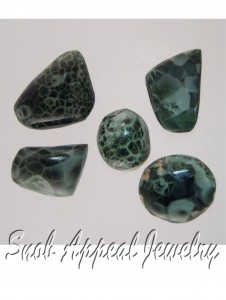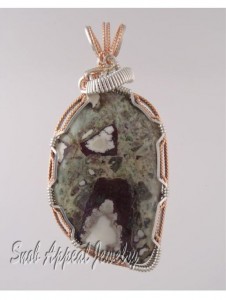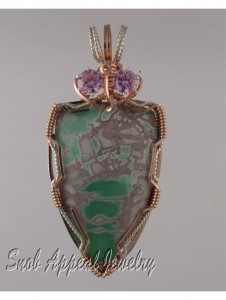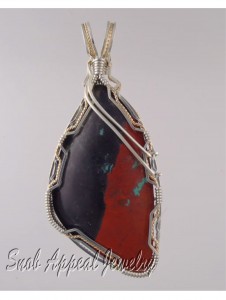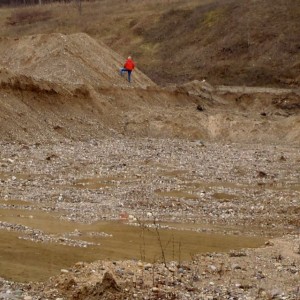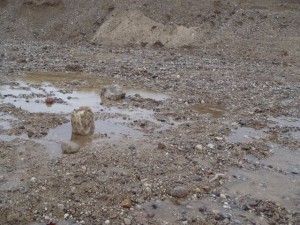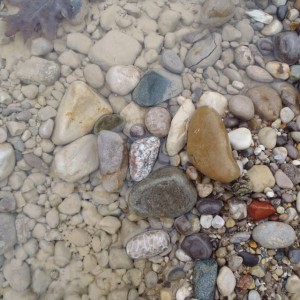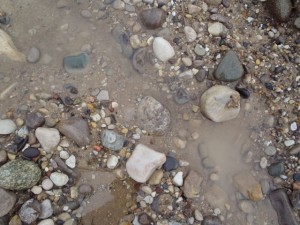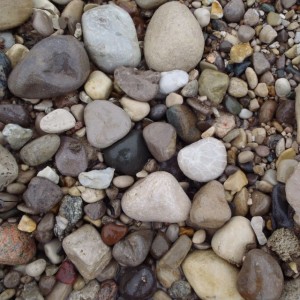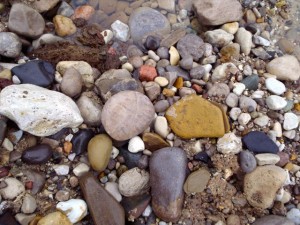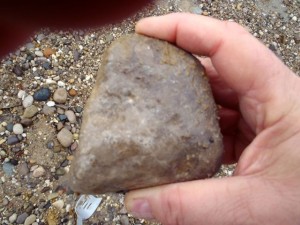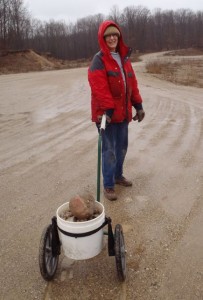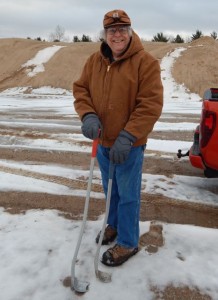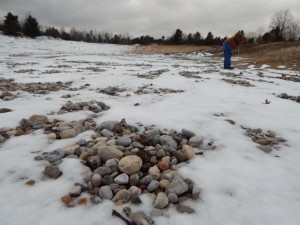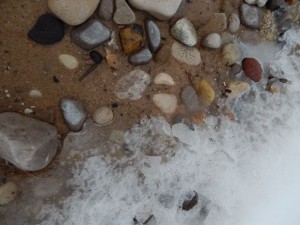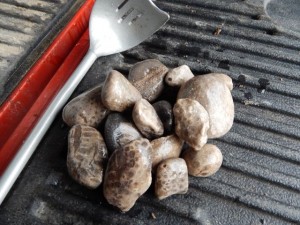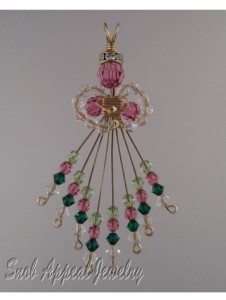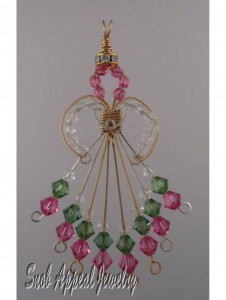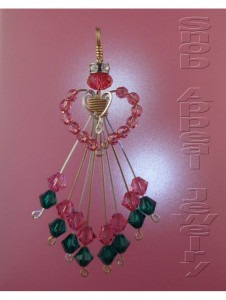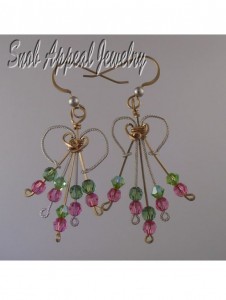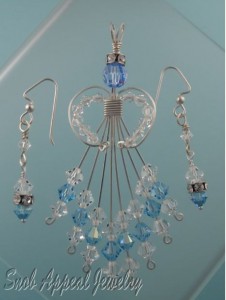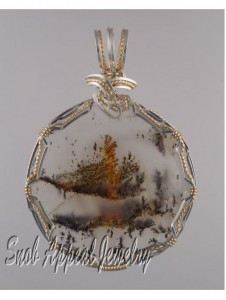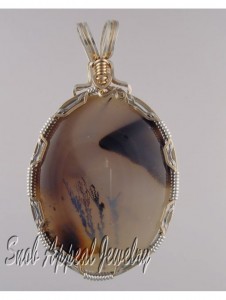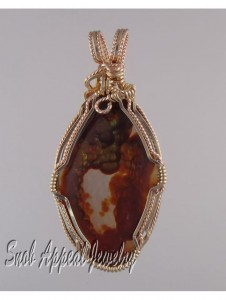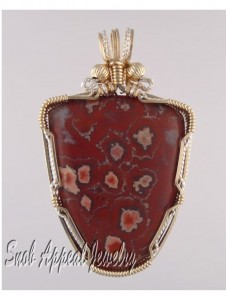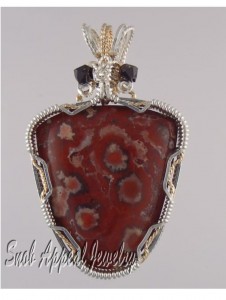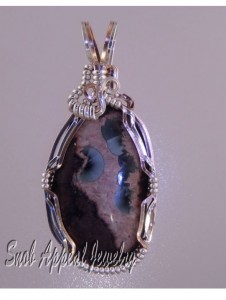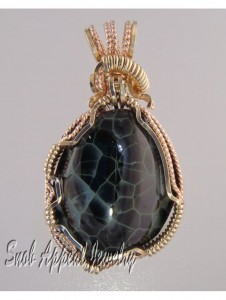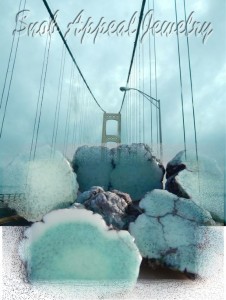
When I cross the mighty Mac, my mind drifts to Centennial Treasures; Especially when the sky matches perfectly. No, I did not re-touch the colors at all. It was amazing!
I find it wondrous that we can actually make friends “on Line”. People we may never meet in person, but somehow they become friends through some site you follow, or some Facebook Group you belong to. I can’t believe how many people I meet on Facebook become good friends. A few I have met in person, a few I will never meet, but that is OK too.
Diana Smith is one of my Facebook friends and follows my comments in various groups and on my FB business page. If you have friended Snob Appeal Jewelry on FB, you know I post up my new jewelry there first. I sometimes do a blog on pieces later, but the new stuff goes on Facebook first when I am freshly excited about it.
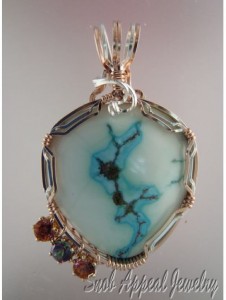
Bonnie's Birthday Pendant-I named this "Copper Strike"
I recently, and in the past, posted up pendants made from the very rare blue Datolite from the Centennial Mine. Centennial Datolite is so very scarce and beautiful. Diana saw a piece of jewelry I made, and mentioned her Great Uncle had lost his life in an accident at the Centennial. She wanted a Centennial Datolite Pendant as a family heirloom and as a tribute to her Uncle.
I was happy to make her something that was very special and very sentimental to her family from Centennial Datolite.
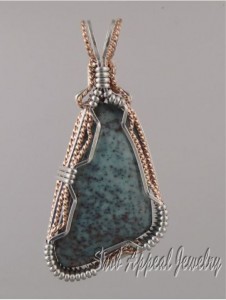
Diana's Memorial Pendant
She agreed to co-author this blog. I really appreciate her sharing her family history like this. This is one of my favorite all time blogs. Here’s what she says of her uncle:
Michele (Michael) Picchiottine
Family stories can draw us into a world of the past that strikes a chord within us and forms a bond with someone we never knew. As I researched our family history I formed that bond with the 21 year old brother of my great grandfather, Michele (Michael) Picchiottino. The Italian world was in political and economic chaos and poverty was rampant. The copper industry in Minnesota and Michigan’s U.P. offered plenty of opportunity for immigrants. Some of our family members moved to Michigan and several of them were employed in the mines. The hours were long, the conditions horrific, and many miners died. On June 13, 1891, Michele was working at Centennial Mine #3 as a laborer when he fell from a tram car on the 25th level and was run over. He joined the list of dead miners that year.
Twenty one years old, barely a man by today’s standards. A life never to be lived. His story of all those I have found in our history probably speaks to me the most. I spent my entire teaching career preparing young people to think about the choices they were making that would direct them into a successful adult life. But Michael never had that chance. As he stood on the threshold of adulthood, his life was cut short.
I told this story to Don Reed and asked him if he could make something we could pass down as a family memorial for this young man. Don suggested the minerals he had worked with ….a small piece of blue/green datolite, copper, and silver, Simple, strong and yet beautiful. The datolite is pretty much gone today , only a memory like Michael. Only a few pieces can be found here and there. We decided on plain, as Micheal’s lifestyle would have been, but solid. The pendant grew under Don’s touch and I could hardly wait to see it. I was so excited. Don did not keep me waiting long. Four days after he began, it arrived. I opened the envelope and fell in love. It was everything I had hoped for. I showed it to the girls. My daughter loves it. My granddaughter also loves it. We will all be very happy when we wear it. No, it won’t bring Micheal back, but it will keep him near our hearts.
THANK YOU, Don for knowing what I wanted, and how to make it look great. Your skills, your creativity, your patience and your speed were much appreciated. You may be sure I Will be shopping with you again. DIANA SMITH
Houghton County Mining Inspector Report
Back to Accident Name Index
| Page No. | 7 |
| Full Report | Accident 21. Michael Pichiotine got onto a loaded skip at the 25th level No. 3 shaft Centennial mine to ride to the surface and when up about twenty-five feet fell off when the skip passing over him killed him instantly. An inquest was held before Justice CRUSE at which the jury exonerated the Mining Company and its officers from all blame. |
| Accident No. | 21-1891 |
| Source | s1 |
| ID | r21 |
Source Information
| Source Name | Inspector | Library Call No. | ID |
|---|---|---|---|
| Report of the Mine Inspector of Houghton County Michigan for the Year Ending September 30 1891 | Josiah Hall Mine Inspector | Michigan TN 272 .H68z 1890/91 | s1 |
| Report of the Mine Inspector of Houghton County Michigan for the Year Ending September 30 1892 | Josiah Hall Mine Inspector | Michigan TN 272.H68z 1892 | s2 |
| Mine Inspectors Report for Houghton County, Mich. For the Year Ending September 30th 1893 | Josiah Hall Mine Inspector | Michigan TN 272.H68z 1893 | s3 |
| Mine Inspectors Report for Houghton County, Mich. For the Year Ending September 30th 1894 | Josiah Hall Mine Inspector | Michigan TN 272.H68z 1894 | s4 |
| Mine Inspectors Report for Houghton County, Mich. For the Year Ending September 30th 1895 | Josiah Hall Mine Inspector | Michigan TN 272.H68z 1895 | s5 |
| Mine Inspectors Report for Houghton County, Mich. For the Year Ending September 30th 1890 | not named | Michigan TN 272 .H68z 1889 | s6 |
| Mine Inspectors Report for Houghton County, Mich. For the Year Ending September 30th 1897 | not named | Michigan TN272 .H68z 1897 | s7 |
| Mine Inspectors Report for Houghton County, Mich. For the Year Ending September 30th 1900 | not named | Michigan TN272 .H68z 1900 | s8 |
Data contributed by: Patricia Wazny-Hamp Copyright © 2015
I find it very interesting that it was common practice back in the day to exonerate the mining companies. It was commonly accepted by the courts that miners knew the dangers of mining and by accepting employment in the mines, they also accepted the dangers. You hardly ever had any case where a fatality was the mining companies fault.
The panels that decided these cases were comprised of individuals employed in management of one mine or another, so the odds were stacked against any miner or their heirs ever getting anything as recompense. Miners lived in company housing and exclusively used company stores to buy what they needed. After paying rent and store bills, there wasn’t much left. Liability on the mines and mine owners was pretty much non existent. The miner’s wives were hesitant to sue the mines in fear of losing housing and/or any small pension that they might be receiving because of the kindness and concern of the benevolent mine management. The lack of protections was one of the many conditions that led to turmoil between labor and management and resulting strikes and protests.
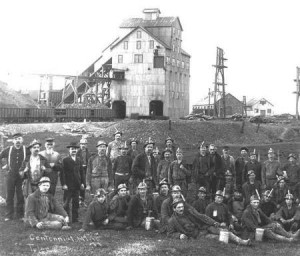
The Centennial Mine in it's heyday.
The mines did not even care enough to get the spelling correct on the miner’s names. Especially difficult were Italian, Finnish, and Polish names. As you can see on the mine inspectors death investigation report, Mr. Picchiottino was misspelled. The entire report of a miner’s death investigation in a few sentences. No way this would happen today. You can read more about the life and times of the copper miners in three books by Larry D. Lankton, especially Cradle to Grave: Life, Work and Death at the Lake Superior Copper Mines. Another interesting book about the era is Death’s Door: The Truth Behind the Italian Hall Disaster and the Strike of 1913 by Steve Lehto.
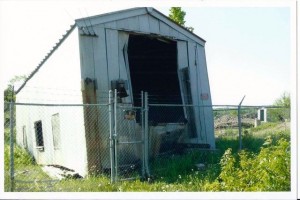
Centennial Mineshaft today
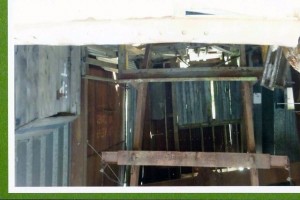
An old ladder and a broken down building at Centennial
Mineshaft #6 is still visible from M-41 on the west side, north of Calumet in Centennial. The Centennial Mine opened in 1869 and closed in 1968, became flooded, was dewatered in the mid-1970’s by Homestake, but the operation was abandoned within a few years. Shafts 6 and 3 worked the Calumet and Hecla Conglomerate and yielded 1.9 billion kg of refined copper. This was the largest lode in the district and comprised one-third of the total Native Copper mined in the Keweenaw Copper District.
I love the Keweenaw Datolite, but especially the Blue from the Centennial. This blue tinge is probably caused by Kinoite. You would be hard pressed to find a random piece of Centennial around anymore. I only have a small supply left. Copper World (aka the best Gift Shop around Lake Superior), usually has a piece or two of Centennial Jewelry I’ve made. If Blue Centennial Datolite were an animal it would be on the endangered species list!
I appreciate Diana adding personal interest and her family history to this blog.








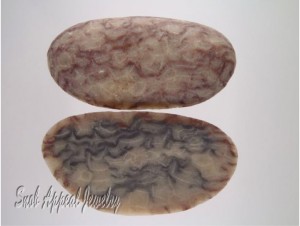
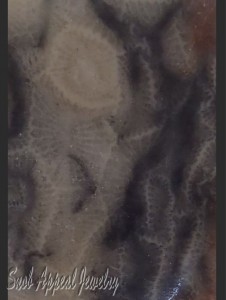
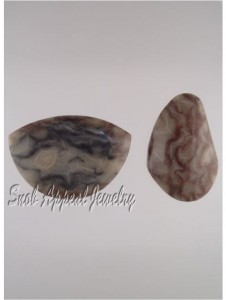
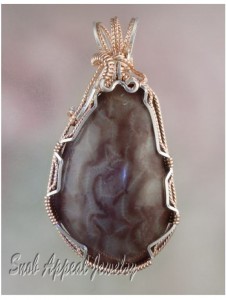
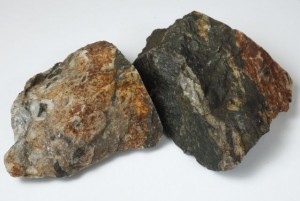
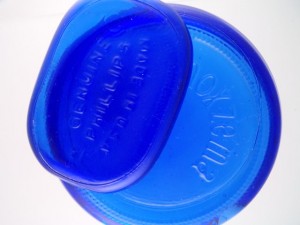
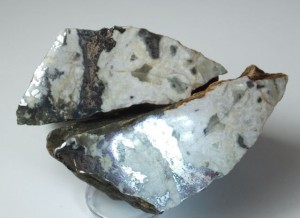
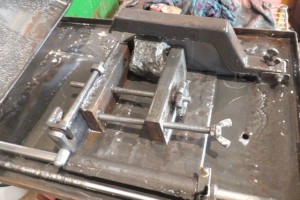
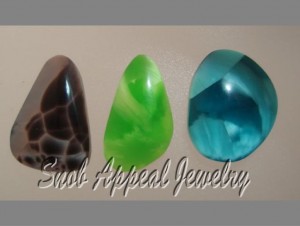
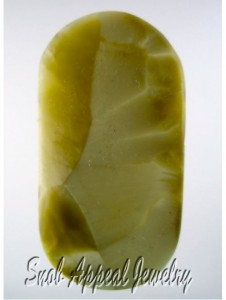
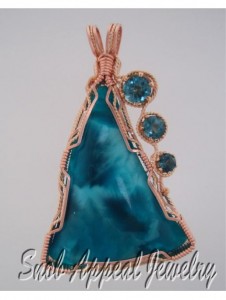
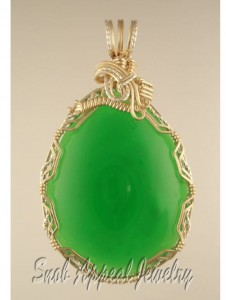
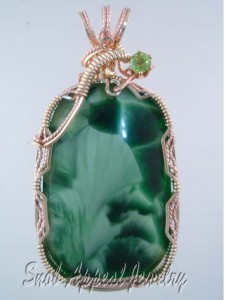
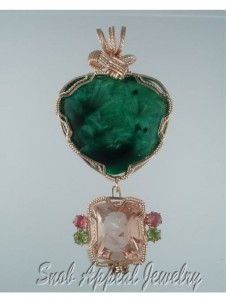
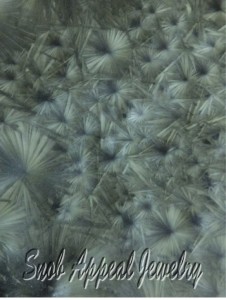
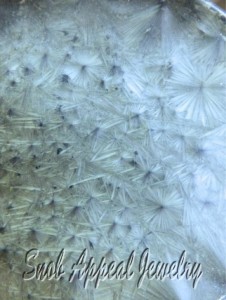
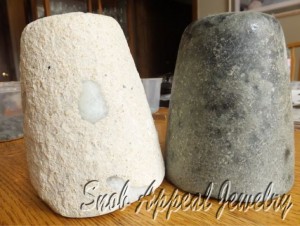
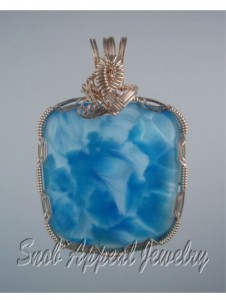
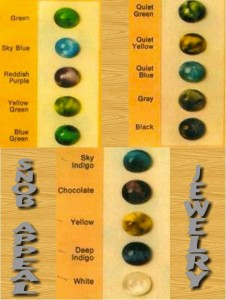
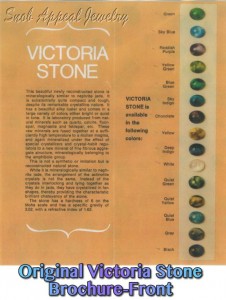
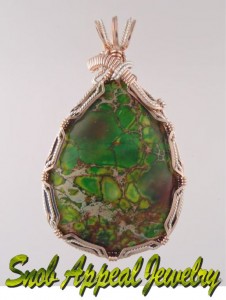
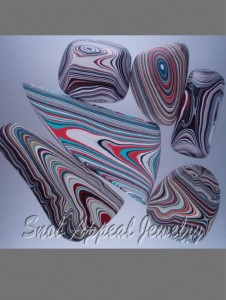
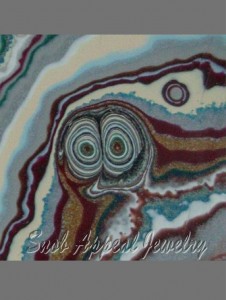
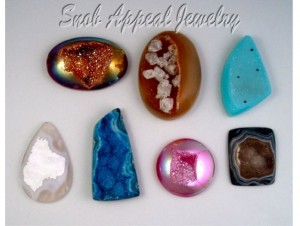
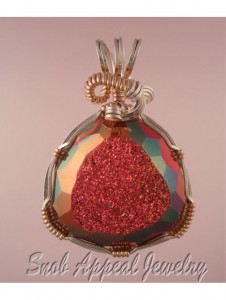
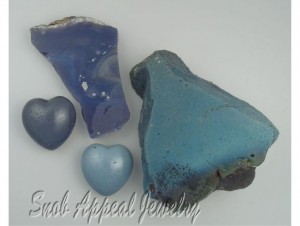
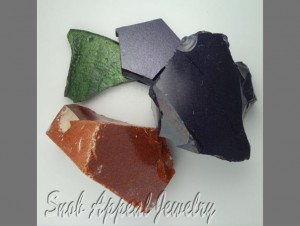
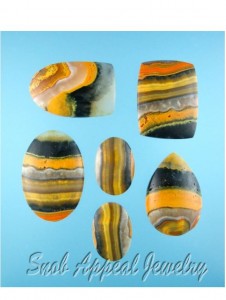
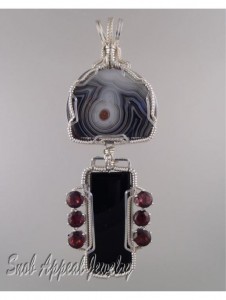 My New Years Pendant this year was inspired by both a dream I had and something that matches our company colors of Red, Black, and White. I pictured this exact ending in my dream. Tuxedo Agate is a dyed Brazilian Agate. The dyeing procedure is the same as is used in the manufacture of Black Onyx. I’m betting you did not know that most Black Onyx was dyed. I combined a piece of Onyx with a great piece of Tuxedo Agate and enhanced the pendant with Rhodolite Garnets. The wire is Argentium Sterling. A few hours of careful work produced a pendant I’m quite proud of. I expect this pendant, as well as the rest of the new pendants in this blog will be for sale in the near future.
My New Years Pendant this year was inspired by both a dream I had and something that matches our company colors of Red, Black, and White. I pictured this exact ending in my dream. Tuxedo Agate is a dyed Brazilian Agate. The dyeing procedure is the same as is used in the manufacture of Black Onyx. I’m betting you did not know that most Black Onyx was dyed. I combined a piece of Onyx with a great piece of Tuxedo Agate and enhanced the pendant with Rhodolite Garnets. The wire is Argentium Sterling. A few hours of careful work produced a pendant I’m quite proud of. I expect this pendant, as well as the rest of the new pendants in this blog will be for sale in the near future.